Research – Kathleen Walne (1915-2011)
Kathleen's life and work
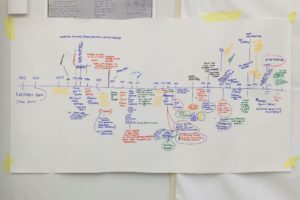
Working timeline of Kathleen Walne’s life and work
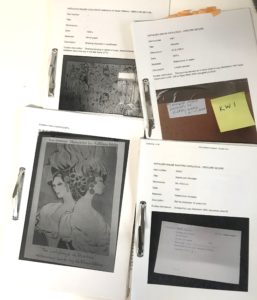
Catalogues of Kathleen Walne’s work and archive material
The above timeline and simple catalogues were made following visits to Kathleen Walne’s family over a period of years (2017-2022). They are part of a slow process of picking up various pieces of information and capturing it for ourselves.
This helped us gain a deeper understanding of the social / political / personal impacts on Kathleen’s creative life such as:
Gender expectations
Need for financial stability
Marriage
Second world war
Motherhood
Struggle for housing in post war London
Caring responsibilities
Space – living in a small flat with three children
Talking to her family we learnt how Kathleen’s speaking voice sounded. It was soft and she had a Suffolk accent. Slowly our sense of Kathleen got richer.
We were very fortunate to spend a morning with Kathleen’s sister (who was 103) a few months before she passed away peacefully in 2020. She told us stories of their childhood. We have a recording of this interview which we have shared with the family.
The significance of time and building a relationship of trust with Kathleen’s family has meant we have had access to hearing Kathleen’s voice more intimately – through spending time with them and her work and reading the memoir Kathleen wrote for her grandchildren.
Visiting museums and collections
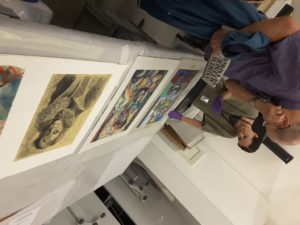
Kathleen’s work in Towner’s stores
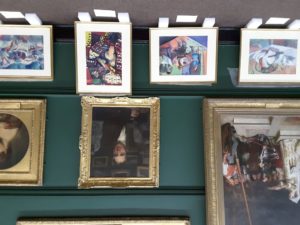
Kathleen’s work at Salford Museum & Art Gallery
Kathleen’s work from the 1930s
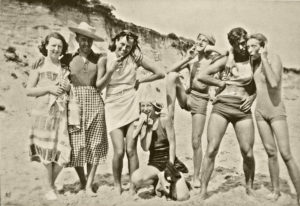
Kathleen (right) on Minsmere Beach with her Ipswich Art School friends 1934
Lucy Wertheim had a significant impact on her life as an artist – Lucy bought Kathleen’s paintings as she made them and included her in group and solo exhibitions and public collections. Lucy was a gallerist and collector, particularly passionate about supporting young British artists.
The thirty year gap 1940 - 1970
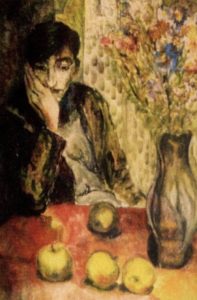
Kathleen’s card to her friend Freddie which makes reference to the gap in her painting life
We imagine when she moved to Brighton as a carer for Lucy Wertheim in the late 1960s that it would have connected her to her earlier creative life. After Lucy died in 1971 Kathleen started painting and exhibiting again.
Kathleen’s later creative life
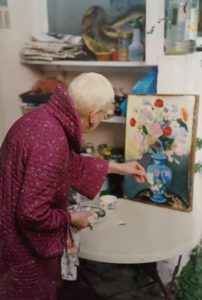
Kathleen painting in the garden of her Brighton home
Kathleen worked at the kitchen table or in her garden, and she exhibited locally in the Brighton Lanes, in shop windows and friends’ homes. She made Christmas cards every year that she sent to friends and family. She maintained a personal archive and made sure her story was captured and shared both through Mixed Palette by David Buckman (a book about Kathleen and her husband Frank’s painting lives) and in her own unpublished memoir written for her grandchildren. Kathleen continued painting into her nineties.
From the mid-1980s the works by Kathleen that Lucy Wertheim had gifted to public collections were included in solo and group exhibitions at Salford Museum and Art Gallery, Towner Eastbourne, Wakefield Art Gallery and Dudley Museum and Art Gallery.
Residency at Towner Eastbourne, 12-17 July 2022
The residency took place for one week during the Wertheim exhibitions, A Life in Art: Lucy Wertheim and Reuniting the Twenties Group, 11 June 2022- 25 September 2022.
During the residency we created an installation of Kathleen’s work with our own work and displayed Kathleen’s archive material. It was a unique chance to have all the material in one room.
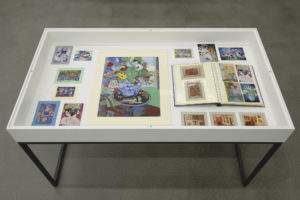
A display of Kathleen’s work, including her photographs and cards
As part of our research for the questions we looked at acquisition policies from different collections – we were interested to see how they had changed over time. We shared a small selection of policies that are available publicly in the studio as examples.
Our questions
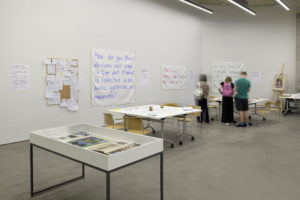
Our questions in the residency studio at Towner Eastbourne
How do you think decisions were made in the past of what is collected in our public galleries and museums?
How would you change what is collected and what we see?
Do you know or remember someone with a creative outlet in their life? What do they do?
Who?
How were they creative?
Is there a record?
Many visitors shared their responses to our questions on a noticeboard in the residency studio
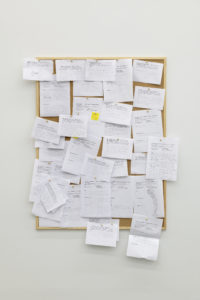
Towner visitor responses to our questions
Residency workshops
During the residency we explored our idea of active research and invited people to work alongside us through an artists workshop day and a book group.
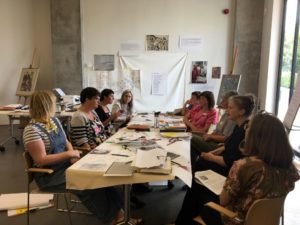
Researching the women artists in Towner’s Lucy Wertheim exhibitions
In the book group we looked at excerpts from Lucy Wertheim’s book Adventure in Art that seemed most relevant to her role as a woman gallerist, collector and supporter of women artists. We also shared information on Lucy’s connection to Kathleen Walne. Participants were particularly interested in the power relationship between gallerist and artist.